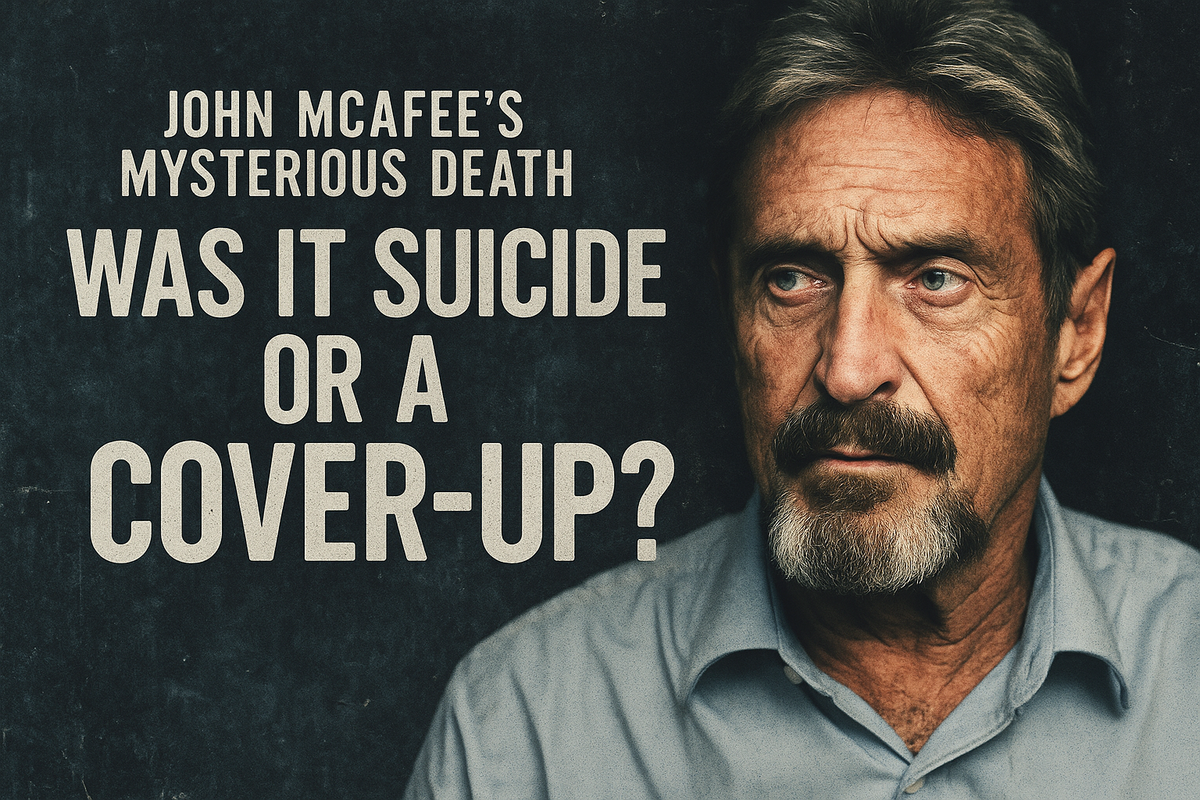John McAfee’s Mysterious Death: Was It Suicide or a Cover-Up?
John McAfee’s death in a Spanish prison sparked global controversy. Was it truly suicide, as authorities claim, or part of a larger cover-up? His cryptic messages and Janice McAfee’s doubts fuel ongoing speculation

A Death That Still Doesn't Add Up: The Last Hours of John McAfee
June 23, 2021, was the day that John McAfee, the maverick tech billionaire turned global fugitive, was discovered dead in a Spanish prison cell. The official line? Suicide by hanging. The truth? Perhaps much worse.
That morning, McAfee was dealt devastating news. Following months of legal uncertainty, Spain's supreme court had finally endorsed his extradition to the United States on federal tax evasion charges. Having up to 30 years in prison in a nation he no longer felt secure in, most thought a dramatic response was forthcoming. But those nearest to him said there were no indications of desperation.
His wife, Janice McAfee, went on to confirm their last phone call as being peaceful and rife with plans for the future. He reportedly said to her, "I love you. I'll talk with you tonight." He wasn't depressed. He wasn't broken. And most ominously John McAfee had openly cautioned that if he was discovered in his cell dead by what appeared to be suicide, we shouldn't believe it.
Even more chilling were the digital breadcrumbs he left: enigmatic tweets, an unusual cryptocurrency known as $WHACKD, and a tattoo on his bicep from years ago, spelling out one word now ringing like a prophecy—WHACKD.
Who Was John McAfee? The Mad Genius Behind the Antivirus Revolution
John David McAfee was born in 1945 on a U.S. Army base in the United Kingdom and brought up in Roanoke, Virginia. He graduated with a degree in mathematics and then worked for large corporations such as NASA, Lockheed Martin, and Xerox.
But his fame came later, in the late 1980s, when he founded McAfee Associates, the firm which brought commercial antivirus software to the masses. During the peak of the PC boom, the software was a bestseller. In 1994, McAfee sold his interest for millions.
And then things went awry.
Rather than pursue a typical post-CEO existence, McAfee plunged into one of psychedelics, yoga retreats, herbal medicine, dot-com flops, cryptocurrency activism, and numerous encounters with the law. His existence became more erratic, but intriguing.
By the 2010s, he had gone from esteemed tech mogul to international fugitive, media darling, and in his own words a man sentenced to death.
Legal Woes & Fugitive Life: A Timeline of Turmoil
2012: Belize Murder Allegation
Residing in Belize then, McAfee was made a "person of interest" for the murder of his neighbor, Gregory Faull, who was discovered dead with a gunshot wound. McAfee maintained innocence and said he was being framed by corrupt local government officials. He left the country and reappeared later in Guatemala, then was deported to the U.S.
2016: Libertarian Presidential Campaign
McAfee reinvented himself as a radical libertarian freedom fighter. He ran for President of the United States on the Libertarian ticket, promising privacy rights, decriminalization of drugs, and freedom for crypto. Although he lost, he cemented a new persona: cypherpunk outlaw.
2018–2020: IRS Hunt and Crypto Plans
He faced charges of not filing tax returns between 2014 and 2018, even though he had earned millions from promotions, speaking fees, and crypto trading. Later, the SEC accused him of promoting Initial Coin Offerings (ICOs) on Twitter in pump-and-dump operations.
He was aboard a yacht, hiding from authorities, and posting freely about U.S. agents "hunting" him.
October 2020: Spanish arrest
McAfee was eventually apprehended at Barcelona Airport as he attempted to board a flight to Turkey. He had spent years in exile but now risked being extradited to the U.S. His appeal to be spared it was rejected on June 23, 2021.
Just hours later, he was dead.
Cryptic Tweets and the $WHACKD Tattoo
In his final years, McAfee made Twitter his digital diary of paranoia, philosophy, and foreshadowing.
And then there was this one tweet, among the thousands:
"Receiving subtle messages from US officials that, in essence: 'We're coming for you, McAfee! We're gonna kill yourself.' I got a tattoo today just in case. In the event of my suicide, I didn't. I was whackd. Check my right arm."
— November 2019
It turns out the tattoo was not fake. On his right arm: $WHACKD, all capital letters, black ink.
McAfee also had a crypto token, of the same name $WHACKD with a chilling premise. Each transaction held a random possibility of being burned completely, mirroring McAfee's opinion of a violent, unjust system that "erases" individuals without notice.
His fans thought that he was utilizing the token and the tattoo as an insurance policy a trail of breadcrumbs that would confirm suspicions in the case of his unexpected demise.
Another tweet, released after Jeffrey Epstein's death, read:
"I am okay in here. I have friends. Food is good. Everything is fine. Be aware that if I hang myself, à la Epstein, it will be no fault of mine."
These were not mere tweets. They were deliberate, aimed, and public posts.
Janice McAfee Speaks Out: "He Was Not Suicidal"
Following his death, Janice McAfee went on social media and the media to denounce what she referred to as a "government-sanctioned execution."
In her account:
- John was positive and psychologically robust.
- He possessed future intentions, such as appeals and future calls.
- He believed he would succeed in a legal fight to prevent extradition.
- He had no previous suicide attempts and did not want to die in an American prison.
- She feels that he was killed and that the suicide story was just a cover-up.
She also objected to the Spanish authorities' version, calling for an independent autopsy, protesting the secrecy under which the supposed suicide note was carried out, and denouncing the rush of cremating his body.
As per Janice, John was afraid of U.S. authorities but was sure that he could battle the extradition. He had a lawful plan under way and was hopeful about the outcome.
More significantly, she stated, "John would never kill himself. We talked every day. He liked living. He wasn't suicidal."
The family's lawyers filed motions to prevent the release of McAfee's body until an independent autopsy was performed. But Spanish authorities, however, declared the death a suicide and released the body eventually.
Janice also said the U.S. government's silence was deafening. There was no official inquiry into possible foul play, no State Department protest, and no mention of how a high-profile prisoner died hours after a major court ruling.
Janice believed McAfee was a man who danced with peril but never would have chosen to die.
Inside Brians 2 Prison: Security, Surveillance & Silence
Brians 2 is Spain's newer penitentiary. Situated approximately 20 miles from Barcelona, it houses prisoners in pre-trial or extradition status.
McAfee was housed in Module 1, a section generally reserved for elderly prisoners. As deemed secure, Brians 2 has reported suicides and accused loopholes in watch procedures.
He was not under suicide watch, given his high-profile stature and history of sensationalized allegations.
Holes in key details to note are:
- Surveillance tape from the cell hallway never made public.
- The claimed suicide letter its contents still unknown.
- Testimonies of prisoner and corrections officer mainly not made public.
- Cremation schedule granted quickly without independent examination.
These omissions fueled web conspiracy theories. Why wasn't McAfee continuously under monitoring? Why wasn't autopsy conducted openly? Why the hurry?
Government Silence and Public Speculation
Curiously, once the news was out, both the U.S. and Spanish governments fell largely silent. The U.S. Justice Department made a short statement confirming his passing, but said nothing about the circumstances. No congressional leaders demanded an investigation. No agencies provided condolences or commentary.
This silence merely fueled the fire.
The internet already primed by Epstein's jail-cell “suicide” in 2019 exploded with theories. QAnon circles claimed McAfee had secret files on powerful people. Others speculated he had backdoor access to government data via his antivirus software. Some even claimed he was alive and hiding.
In 2020, McAfee had tweeted that he had "more than 31TB" of incriminating information on government officials that he would leak if anything were to happen to him. A cryptic Telegram channel emerged after his death, suggesting it was connected to a "dead man's switch." The channel was erased shortly thereafter.
Whether these were rumors or not is unclear. But the uncertainty of McAfee's death created the perfect storm of digital conspiracy and suspicion.
Still Unanswered Questions That Haunt
Even with media hype and public attention, some pivotal questions linger:
Was McAfee Paranoid or Prophetic?
McAfee was brilliant, erratic, controversial many things but he was not stupid.
Was he a paranoid man conjuring up specters in every governmental move? Or was he a truth speaker, well ahead of his time, targeted for his information and sway?
Think about this:
- He threatened his potential murder again and again.
- He left both physical and electronic evidence to that purpose.
- He was arrested at a time of growing U.S. surveillance scandals.
- He was a million-plus follower, anti-establishment voice with scathing secrets.
If nothing else, McAfee forecasted how the world would respond and he was correct. The public didn't accept the government narrative. They demanded more.
And they still do.
Final Reflection: The Mystery That Refuses to Die
John McAfee spent the final decade of his life attempting to outrun the systems from which he had profited. Whether in Silicon Valley, fleeing across Central America, or in prison in Spain, he proclaimed that he was a man pursued not for his wrongdoing but for his knowledge.
His death, rather than serving as a conclusion, has deepened the mystery.
If he was killed, it's a sobering precedent: that fame, wealth, and a big mouth don't make you immune to enemies you can't see. If he actually did kill himself, then we have the bitter irony of a man who cried wolf so frequently that no one did anything when the wolf came.
Was It Suicide… or Silencing?
John McAfee was a madman and a genius. A provocateur and a prophet. A man who flirted with and feared chaos. Who danced with danger throughout his life—and when the music finally ceased, the conclusion felt so scripted.
- A suicide that came too neatly.
- A tattoo that itself read like a dying declaration.
- A tweet that continues to taunt his followers to this day.
Did McAfee actually lose hope and kill himself? Or did someone else determine that John McAfee the guy who simply couldn't shut up had finally spoken too much?
His death ended the book. But the story still isn't finished.
Was it suicide… or silencing?
Sources
- Reuters
- BBC
- Rolling Stone
- Vanity Fair
- The Independent
- Business Insider
- Archive.org Tweet Archives
- Official Spanish Legal and Autopsy Reports
For more legal exposes and truth-behind-glamour stories, subscribe to AllegedlyNewsNetwork.com




